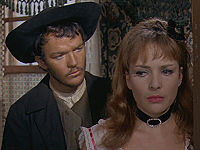Requiescant Review
Requiescant

|
| REQUIESCANT (1967) |
Cast:
Music: Director: |
Political allegory has always been a strong component in the Italian Western. Some films are heavier on it than others but it is visible in many spaghettis. Requiescant is among the more overtly allegorical of the non-Zapata Spaghettis. So it comes as no real surprise to know that Carlo Lizzani, the director, was himself a Communist. And if that is not evidence enough, we have famed director, Pier Paolo Pasolini, in a supporting role as a revolutionary priest. This film is the story of a young Mexican boy who is raised by Anglo Catholics after his family and people are slaughtered by a group of Aristocratic villains. As a man, he is sent to return his runaway foster sister to their parents. His journey leads him on an unexpected path into gunfighting and class warfare.
Though it sounds deadly serious, the film has a feeling of lightheartedness to it that makes the heavy political message easier to digest. And though the Communistic parallels are obvious, they for the most part don't feel forced. But that isn't to say it's layed on thin, because it surely isn't. But it doesn't run through the cliches of political film-making as much as you'd think. Political allegory aside, we have a pretty standard plate of Spaghetti here. If maybe a little eccentric, compared even to most other spaghettis.
It's actually quite a stylish film. There are many sequences that are filmed in the non-realistic, pure spectacle, style of many great spaghettis. It is here where the film shines (this has always been one of my favorite spaghetti traits). One famous sequence has our hero and the Draculoid Mark Damon engaging in a drinking/shooting competition in the basement of Damon's villa. The Baroque look and complete lack of realism in this scene and many others is one of Requiescant's best features. It is scenes like this that make the film easier to watch. Another noticeable aspect is the violence of the film. The opening scene is especially effective with the band of unarmed Mexicans mowed down by Gringo machine guns. Maybe it is a reference to the French new wave where humor is juxtaposed with violence.

|
Though a very interesting and enjoyably offbeat film, Requiescant is not without problems. The plot of the film is somewhat hard to identify. We know why our hero is out there getting involved in this stuff. But once Mark Damon's villain is introduced, the entire plot we have been introduced to becomes secondary to the film's political allegory. This isn't really a problem until our hero's actions and emotions don't really correspond to the main plot. It seems as though he has subconciously forgotten about his quest and decides instead to get himself involved with a group of revolutionary peasants. The other problem is the pacing of the film. It moves quite slowly and in between the stylistically alert scenes, there are several very flat scenes that are increasingly uninteresting. But towards the end, the pace picks up a bit. The final and smallest problem lies in Pasolini's character. He behaves like a mother, often chastizing the our hero for his killing instincts which of course make him a rather hypocritical character. Among that, he often lapses into elongated political and social speeches which is probably the only place in the film that becomes overtly preachy about it's topic. But I guess that's why they had Pasolini play the role.
Despite the cheap look of the film (Roman locations), there are many great visual touches in some scenes. The sets in Damon's villa are very theatrical. And later in the film, the hero has a very heavy rotoscoped flashback. Aside from some of these nice visual touches, Riz Ortolani's stinging score is also quite good. The main tune features Ortolani's usual menacing electric guitar riffs. When the film's Mexican characters become more numerous, a heavily horned and fast paced tune is often heard, very similar to that in Night of the Serpent. And for the lighthearted travelling scenes, we have a nice harmonica based song.
It's not a perfect film, but it has enough redeeming qualities to get my approval (for what it counts). I viewed the Wild East disc which is eqaully imperfect. It is clear and fairly devoid of too many scratches but isn't very sharp. For extras, we have a Lou Castel interview also seen on the Matalo disc. And it just so happens that he discusses both films. This is the best version for US based fans who don't want to go through the trouble of ordering overseas copies.
-- Korano 23:41, 22 August 2010 (UTC)





